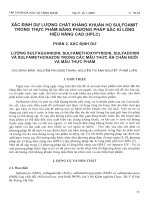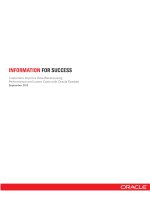Enterprise DBA Part 2: Performance and Tuning Volume 1 • Student Guide pdf
Bạn đang xem bản rút gọn của tài liệu. Xem và tải ngay bản đầy đủ của tài liệu tại đây (2.38 MB, 424 trang )
30052GC10
Production 1.0
September 1999
M09213
Enterprise DBA Part 2:
Performance and Tuning
Volume 1 • Student Guide
Author
Dominique Jeunot
Technical Contributors
and Reviewers
Bruce Ernst
Richard Foote
Antonio Florindo
Steven George
Joel Goodman
Scott Gossett
Lex de Haan
Donna Hamby
Scott Heisey
John Hough Jr.
Peter Kilpatrick
Kurt Lysy
Michael Moller
Howard Ostrow
Thomas Raes
Shankar Raman
S. Roo
Ulrike Schwinn
Roger Simon
Anthony Woodell
Publisher
Kelly Lee
Copyright Oracle Corporation, 1999. All rights reserved.
This documentation contains proprietary information of Oracle Corporation. It is
provided under a license agreement containing restrictions on use and disclosure
and is also protected by copyright law. Reverse engineering of the software is
prohibited. If this documentation is delivered to a U.S. Government Agency of the
Department of Defense, then it is delivered with Restricted Rights and the
following legend is applicable:
Restricted Rights Legend
Use, duplication or disclosure by the Government is subject to restrictions for
commercial computer software and shall be deemed to be Restricted Rights
software under Federal law, as set forth in subparagraph (c) (1) (ii) of DFARS
252.227-7013, Rights in Technical Data and Computer Software (October 1988).
This material or any portion of it may not be copied in any form or by any means
without the express prior written permission of Oracle Corporation. Any other
copying is a violation of copyright law and may result in civil and/or criminal
penalties.
If this documentation is delivered to a U.S. Government Agency not within the
Department of Defense, then it is delivered with “Restricted Rights,” as defined in
FAR 52.227-14, Rights in Data-General, including Alternate III (June 1987).
The information in this document is subject to change without notice. If you find
any problems in the documentation, please report them in writing to Education
Products, Oracle Corporation, 500 Oracle Parkway, Box SB-6, Redwood Shores,
CA 94065. Oracle Corporation does not warrant that this document is error-free.
Oracle is a registered trademark and Oracle and all Oracle products are
trademarks or registered trademarks of Oracle Corporation.
All other products or company names are used for identification purposes only
and may be trademarks of their respective owners.
Enterprise DBA Part 2: Performance Tuning Workshop iii
Contents
Lesson 1: Course Introduction
Objectives 1-2
Lesson 2: Tuning Overview
Objectives 2-2
System Tuning Overview 2-3
Tuning Goals 2-5
Tuning Steps 2-7
Summary 2-8
Lesson 3: Oracle Alert and Trace Files
Objectives 3-2
Diagnostic Information 3-3
The Alert Log File 3-4
Controlling the Alert Log File 3-7
Controlling the Background Processes Trace Files 3-8
User Trace Files 3-11
Controlling the User Trace Files 3-12
Summary 3-14
Quick Reference 3-15
Lesson 4: Utilities and Dynamic Performance Views
Objectives 4-2
Views, Utilities, and Tools 4-3
Dictionary and Special Views 4-5
Dynamic Troubleshooting and Performance Views 4-6
Topics for Troubleshooting and Tuning 4-7
Collecting System-Wide Statistics 4-9
Collecting Session-Related Statistics 4-11
UTLBSTAT and UTLESTAT Utilities 4-14
Examining the Statistics Report 4-17
Library Cache Statistics Section 4-21
I/O Statistics Section 4-22
Latches 4-23
iv Enterprise DBA Part 2: Performance Tuning Workshop
Contents
Latch Types 4-25
Oracle Wait Events 4-26
Statistics Event Views 4-29
Event Management System 4-34
Predefined Event Tests 4-36
Event Frequency and Parameters 4-43
Fix the Problem Detected by the Event 4-45
DBA-Developed Tools 4-47
Oracle Packs 4-48
Performance Manager 4-50
TopSessions 4-52
Oracle Tablespace Manager 4-57
Oracle Trace Manager 4-58
Oracle Expert 4-60
Tuning Categories 4-61
Tuning Recommendations 4-62
Summary 4-64
Quick Reference 4-65
Lesson 5: Tuning the Shared Pool
Objectives 5-2
The Shared Global Area 5-3
The Shared Pool 5-4
The Library Cache 5-5
Tuning the Library Cache 5-7
Terminology 5-9
Diagnostic Tools for Tuning the Library Cache 5-10
Shared Cursors 5-11
Guidelines 5-12
Invalidations 5-14
Sizing the Library Cache 5-15
Global Space Allocation 5-16
Large Memory Requirements 5-18
Enterprise DBA Part 2: Performance Tuning Workshop v
Contents
Tuning the Shared Pool Reserved Space 5-20
Keeping Large Objects 5-22
Anonymous PL/SQL Blocks 5-23
Other Parameters That Affect the Library Cache 5-24
The Data Dictionary Cache 5-26
Diagnostic Tools 5-27
Tuning the Data Dictionary Cache 5-28
Guidelines 5-29
User Global Area and Multithreaded Server 5-30
Sizing the User Global Area 5-31
The Large Pool 5-32
Summary 5-35
Quick Reference 5-36
Lesson 6: Tuning the Buffer Cache
Objectives 6-2
Buffer Cache Overview 6-3
Managing the Buffer Cache 6-5
Tuning Goals and Techniques 6-8
Diagnostic Tools for Tuning the Buffer Cache 6-10
Cache Hit Ratio 6-11
Guidelines for Using the Cache Hit Ratio 6-12
Using Multiple Buffer Pools 6-15
Defining Multiple Buffer Pools 6-16
Enabling Multiple Buffer Pools 6-19
Sizing Buffer Pools 6-20
Recycle Buffer Pool Guidelines 6-21
Calculating the Buffer Pool Hit Ratio 6-24
Segments for the Keep and Recycle Buffer Pools 6-26
Dictionary Views with Buffer Pools 6-27
Other Performance Indicators 6-28
Caching Tables 6-29
LRU Latches 6-30
vi Enterprise DBA Part 2: Performance Tuning Workshop
Contents
LRU Latch Tuning Goals 6-31
Diagnosing LRU Latch Contention 6-32
Resolving LRU Latch Contention 6-33
Free Lists 6-34
Diagnosing Free List Contention 6-35
Resolving Free List Contention 6-37
Summary 6-38
Quick Reference 6-39
Lesson 7: Tuning the Redo Log Buffer
Objectives 7-2
The Redo Log Buffer 7-3
Sizing the Redo Log Buffer 7-4
Tuning the Redo Log Buffer 7-5
Diagnostic Tools for Tuning the Redo Log Buffer 7-6
Guidelines for Tuning the Redo Log Buffer 7-8
Reducing Redo Operations 7-11
Summary 7-13
Quick Reference 7-14
Lesson 8: Database Configuration and I/O Issues
Objectives 8-2
Overview 8-3
Tablespace Usage 8-4
Distributing Files Across Devices 8-6
Oracle File Striping 8-8
Full Table Scans 8-10
Diagnostic Tools 8-13
Using I/O Statistics in report.txt 8-15
Online Redo Log File Configuration 8-16
Archive Log File Configuration 8-19
Tuning Checkpoint 8-22
Checkpoint Tuning Guidelines 8-23
Multiple I/O Slaves 8-25
Enterprise DBA Part 2: Performance Tuning Workshop vii
Contents
Initialization Parameters 8-27
Multiple DBWn Processes 8-28
Tuning DBWn I/O 8-29
Summary 8-30
Quick Reference 8-31
Lesson 9: Using Oracle Blocks Efficiently
Objectives 9-2
Database Storage Hierarchy 9-3
Allocating an Extent 9-4
Avoiding Dynamic Space Management 9-5
Large Extents 9-7
Database Block Size 9-9
Oracle Block Size 9-10
Block Size Advantages and Disadvantages 9-11
Block Packing factors 9-13
Guidelines for Setting the Packing Factor 9-15
Migration and Chaining 9-16
Detecting Chaining and Migration 9-17
Selecting Migrated and Chained Rows 9-18
Eliminating Migrated Rows 9-19
The High-Water Mark 9-21
Table Statistics 9-22
The DBMS_SPACE Package 9-23
Index Reorganization 9-26
Monitoring and Rebuilding Indexes 9-27
Summary 9-30
Quick Reference 9-31
Lesson 10: Optimizing Sort Operations
Objectives 10-2
Sort Operations 10-3
Sort Process 10-5
Sort Area and Parameters 10-7
viii Enterprise DBA Part 2: Performance Tuning Workshop
Contents
Sort Process and Temporary Space 10-11
Tuning Sort Operations 10-13
Avoiding Sort Operations 10-14
Diagnostic Tools for Tuning Sort Operations 10-16
Diagnostics and Guidelines 10-18
Monitoring Temporary Tablespaces 10-19
Configuring Temporary Tablespaces 10-20
Summary 10-22
Quick Reference 10-23
Lesson 11: Tuning Rollback Segments
Objectives 11-2
Rollback Segment Usage 11-3
Rollback Segment Activity 11-4
Rollback Segment Header Activity 11-5
Growth of Rollback Segments 11-6
Transaction Types 11-7
Tuning the Rollback Segments 11-9
Diagnostic Tools for Tuning Rollback Segments 11-10
Diagnosing Rollback Segment Header Contention 11-12
Guidelines: How Many Rollback Segments? 11-15
Guidelines: Sizing Rollback Segments 11-17
Guidelines: Sizing Transaction Rollback Data 11-18
Sizing Transaction Rollback Data Volume 11-19
Guidelines: Using Less Rollback 11-21
Possible Problems 11-23
Summary 11-24
Quick Reference 11-25
Lesson 12: Monitoring and Detecting Lock Contention
Objectives 12-2
Locking Mechanism 12-3
Types of Locks 12-6
DML Locks 12-8
Enterprise DBA Part 2: Performance Tuning Workshop ix
Contents
Table Lock Modes 12-10
Manual Table Lock Modes 12-12
Row-Level Lock in Block 12-16
DDL Locks 12-17
Possible Causes of Lock Contention 12-19
Diagnostic Tools for Monitoring Locking Activity 12-20
TopSessions (Diagnostic Pack) 12-22
Guidelines: Resolve Contention 12-24
Deadlocks 12-26
Summary 12-29
Quick Reference 12-30
Lesson 13: SQL Issues and Tuning Considerations for
Different Applications
Objectives 13-2
The Role of the DBA 13-4
Diagnostic Tools Overview 13-5
The EXPLAIN PLAN Statement 13-6
SQL Trace and TKPROF 13-7
Enabling and Disabling SQL Trace 13-9
Formatting the Trace File with TKPROF 13-10
TKPROF Options 13-11
TKPROF Statistics 13-12
SQL*Plus AUTOTRACE 13-13
Optimizer Modes 13-14
Setting the Optimizer Mode 13-16
Managing Statistics 13-18
Table Statistics 13-20
Index Statistics 13-22
Column Statistics 13-23
Histograms 13-24
Copying Statistics Between Databases 13-26
Plan Equivalence 13-29
x Enterprise DBA Part 2: Performance Tuning Workshop
Contents
Creating Stored Outlines 13-30
Using Stored Outlines 13-31
Maintaining Stored Outlines 13-33
Data Access Methods 13-34
B-Tree Indexes 13-35
Bitmap Indexes 13-37
Reverse Key Indexes 13-42
Index-Organized Tables 13-44
Clusters 13-49
Materialized Views 13-52
Query Rewrites 13-55
Materialized Views and Query Rewrites: Example 13-57
Enabling and Controlling Query Rewrites 13-59
OLTP Systems 13-62
DSS Systems 13-67
Multipurpose Applications 13-71
Summary 13-76
Quick Reference 13-79
Lesson 14: Managing a Mixed Workload
Objectives 14-2
Overview 14-3
Resource Management Concepts 14-4
Resource Consumer Groups 14-6
Resource Plan Directives 14-7
Database Resource Management Example 14-9
Steps in Database Resource Management 14-10
Assigning the Resource Manager Privilege 14-11
Creating Database Resource Manager Objects 14-13
Assigning Users to Consumer Groups 14-16
Setting the Resource Plan for an Instance 14-17
Changing a Consumer Group Within a Session 14-18
Changing Consumer Groups for Sessions 14-19
Enterprise DBA Part 2: Performance Tuning Workshop xi
Contents
Database Resource Manager Information 14-20
Current Database Resource Manager Settings 14-23
Summary 14-24
Quick Reference 14-25
Lesson 15: Tuning with Oracle Expert
Objectives 15-2
Overview 15-3
Types of Tuning 15-5
Starting Oracle Expert 15-7
Tuning Session Scope 15-9
Data Collection 15-12
Collected Data 15-21
Attributes 15-22
Rules 15-24
Analysis 15-26
Recommendations 15-27
Reports 15-28
Implementation 15-32
Summary 15-33
Lesson 16: Multithreaded Server Tuning Issues
Objectives 16-2
Overview 16-3
Multithreaded Server Characteristics 16-4
Configuring the Multithreaded Server 16-6
Monitoring Dispatchers 16-7
Monitoring Shared Server Processes 16-9
Monitoring Process Usage 16-11
Shared Servers and Memory Usage 16-12
Possible Problems 16-13
Obtaining Dictionary Information 16-14
Summary 16-15
Quick Reference 16-16
xii Enterprise DBA Part 2: Performance Tuning Workshop
Contents
Lesson 17: Workshop
Objectives 17-2
Workshop Methodology 17-3
Troubleshooting Scope 17-4
Directories Configuration 17-5
Workshop Database Configuration 17-7
Information Gathering 17-8
Statistics 17-10
Review 17-11
Presentation 17-14
Analysis 17-15
New Statistics 17-17
Results 17-19
Post-Tuning Actions 17-20
Pending Performance Tuning Issues 17-22
Summary 17-23
Appendix A: Practices
Practice 3-1 A-2
Practice 4-1 A-3
Practice 5-1 A-4
Practice 6-1 A-5
Practice 7-1 A-6
Practice 8-1 A-7
Practice 9-1 A-8
Practice 10-1 A-9
Practice 11-1 A-10
Practice 12-1 A-11
Practice 13-1 A-12
Practice 14-1 A-13
Guided Practice 17-1 A-14
Appendix B: Practice Hints
Practice 3-1 Hint B-2
Enterprise DBA Part 2: Performance Tuning Workshop xiii
Contents
Practice 4-1 Hint B-3
Practice 5-1 Hint B-5
Practice 6-1 Hint B-6
Practice 7-1 Hint B-7
Practice 8-1 Hint B-8
Practice 9-1 Hint B-9
Practice 10-1 Hint B-10
Practice 11-1 Hint B-11
Practice 12-1 Hint B-13
Practice 13-1 Hint B-14
Practice 14-1 Hint B-16
Appendix C: Practice Solutions
Practice 3-1 Solutions C-2
Practice 4-1 Solutions C-3
Practice 5-1 Solutions C-8
Practice 6-1 Solutions C-13
Practice 7-1 Solutions C-17
Practice 8-1 Solutions C-18
Practice 9-1 Solutions C-21
Practice 10-1 Solutions C-24
Practice 11-1 Solutions C-27
Practice 12-1 Solutions C-33
Practice 13-1 Solutions C-37
Practice 14-1 Solutions C-44
Appendix D: Redundant Arrays of Inexpensive Disks Technology (RAID)
System Hardware Configuration D-2
RAID Level 0, Nonredundant Striping D-5
RAID Level 1, Mirroring D-6
RAID Level 0+1, Striping and Mirroring D-8
RAID Level 3, Bit Interleaved Parity D-9
RAID Level 5, Block-Interleaved with Distributed Parity D-10
Ranking of RAID Levels Against Oracle File Types D-12
xiv Enterprise DBA Part 2: Performance Tuning Workshop
Contents
Appendix E: Dictionary and Dynamic Performance Views
Dictionary and Dynamic Performance Views E-2
Data Dictionary Views E-3
Dynamic Performance Views E-21
Appendix F: Initialization Parameters
Initialization Parameters F-2
Parameters Definition F-4
1
Course Introduction
1-2 Enterprise DBA Part 2: Performance Tuning Workshop
Lesson 1: Course Introduction
Objectives
Copyright Oracle Corporation, 1999. All rights reserved.
®
Course Objectives
After completing this course, you should
be able to do the following:
• List the important steps for outlining a tuning
methodology
• Use Oracle tools to diagnose performance
problems
• Configure memory resources to optimize
cache operations
• Reconfigure file structures to enhance
performance
Enterprise DBA Part 2: Performance Tuning Workshop 1-3
Objectives
Copyright Oracle Corporation, 1999. All rights reserved.
®
Course Objectives
• Identify and resolve I/O, storage, and database
configuration problems
• Detect and resolve latch and lock contention
problems
• Configure memory and disk resources to
optimize sort operations
• Diagnose and resolve performance issues
associated with the multithreaded server
• List options to enhance performance across
differing application environments
1-4 Enterprise DBA Part 2: Performance Tuning Workshop
Lesson 1: Course Introduction
2
Tuning Overview
2-2 Enterprise DBA Part 2: Performance Tuning Workshop
Lesson 2: Tuning Overview
Objectives
Copyright Oracle Corporation, 1999. All rights reserved.
®
Objectives
After completing this lesson, you should be able to
do the following:
• List the roles associated with the database tuning
process
• Define the steps associated with the tuning
process
• Identify tuning goals
Enterprise DBA Part 2: Performance Tuning Workshop 2-3
System Tuning Overview
System Tuning Overview
Who Tunes?
Everyone involved with the Oracle8i system—system architects, designers,
developers, and database administrators (DBAs)—should think about performance
and tuning in doing their work.
If problems develop, the DBA usually makes the first attempt at solving them.
Why Tune?
The best practice of database tuning is to carefully design the system and application.
The majority of performance gains are realized by tuning the application.
Your system is much less likely to run into performance problems if:
• The hardware can meet user demands.
• Your Oracle8i database was carefully designed.
• Your application developers write efficient SQL programs.
If wrong decisions were made early in the system development process, or if users
now expect much more from the system than they did previously, you may need to
seriously consider improving performance. The longer you delay in addressing the
tuning process, the more it costs in time and resources.
Copyright Oracle Corporation, 1999. All rights reserved.
®
Tuning Questions
•
Who tunes?
– Application designers
– Application developers
– Database administrators
– System administrators
• Why tune?
• How much tuning?
2-4 Enterprise DBA Part 2: Performance Tuning Workshop
Lesson 2: Tuning Overview
How Much Tuning?
You should begin tuning with a clear idea of what you are trying to achieve. Try to
quantify your goals as precisely as possible, in real-world terms. For example:
• Process 10,000 orders each day
• Produce 250,000 billing statements overnight at the end of the month
This course frequently describes Oracle8i tuning objectives and methods, but
ultimately these tuning steps must benefit the users. There is no point in making a
small improvement in the use of the data buffer cache if all users are accessing the data
over a slow network on aging PCs: your tuning efforts will not be noticed.
Tuning is an iterative process—it is not an activity that is performed only once.
Enterprise DBA Part 2: Performance Tuning Workshop 2-5
Tuning Goals
Tuning Goals
Measurable Tuning Goals
When tuning an Oracle8i database environment, the DBA should establish measurable
tuning goals. Without them, it is difficult to determine when you have performed
enough tuning.
• Response time addresses how long it takes for a user to receive data from a
request—for example, the result set of a query—or the time it takes to update a
table, or to generate a report.
• Database availability is also a good measure for tuning goals. Availability can be
backup and recovery procedures, or by shutting down and starting the instance to
tune parameters.
• Database hit percentages provide a good baseline from which to determine if
performance is increasing or decreasing over time.
• Memory utilization is also a valid measure for tuning, because excessive paging
and swapping can impact database and operating system performance. Memory
utilization can also impact database hit percentages.
Copyright Oracle Corporation, 1999. All rights reserved.
®
Examples of Measurable
Tuning Goals
•
Response time
• Database availability
• Database hit percentages
• Memory utilization
2-6 Enterprise DBA Part 2: Performance Tuning Workshop
Lesson 2: Tuning Overview
Establishing Tuning Goals
Your primary goals in tuning an Oracle8i server are to make sure that:
• SQL statements access the smallest possible number of Oracle blocks.
• If a block is needed, it is cached in memory.
• Users share the same code.
• When code is needed, it is cached in memory.
• Where reads and writes are unavoidable, they are done as quickly as possible.
• Users never have to wait for resources held by others.
• Backups and other necessary housekeeping can be done as quickly as possible.
Copyright Oracle Corporation, 1999. All rights reserved.
®
Tuning Goals
•
Access the least number of blocks
• Cache blocks in memory
• Share application code
• Read and write data as quickly as possible
• Ensure that users do not wait for resources
• Perform backups and housekeeping while
minimizing impact
Enterprise DBA Part 2: Performance Tuning Workshop 2-7
Tuning Steps
Tuning Steps
Tuning Steps
The recommended order in which to implement tuning is as follows:
1 The design (if it is possible)
2 The application
3 The memory
4 Input/output (I/O)
5 Contention
6 Operating system
Repeat the tuning process if your goals have not yet been achieved.
The rationale for this structure is that improvements early in the sequence can save
you from encountering problems later. For example, if your applications are using a lot
of full table scans, this may show up as excessive I/O. However, there is no point in
resizing the buffer cache or redistributing disk files if you can rewrite the queries so
that they access only 4 blocks instead of 4,000.
The first two steps are typically the responsibility of the system architects and
application developers; however, the DBA may also be involved in application tuning.
Copyright Oracle Corporation, 1999. All rights reserved.
®
Tuning Steps
1. Tune the design.
2. Tune the application.
3. Tune memory.
4. Tune I/O.
5. Tune contention.
6. Tune the operating system.









